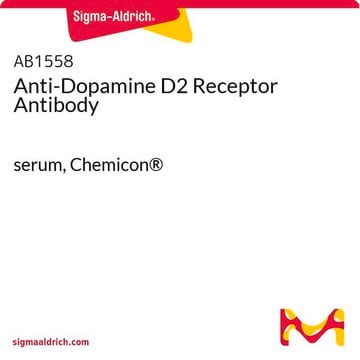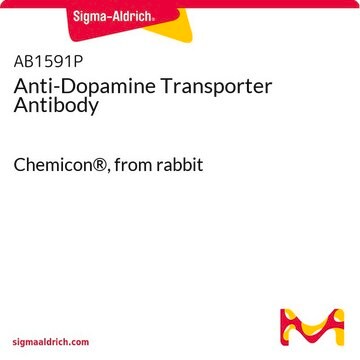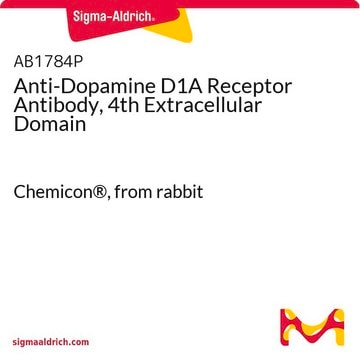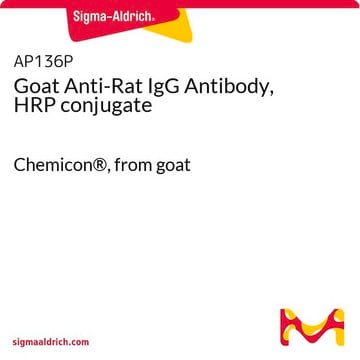MAB5292
Anti-Dopamine D1B Receptor Antibody, clone SG4-D1B
clone SG4-D1B, Chemicon®, from mouse
Sinonimo/i:
Dopamine D5 Receptor
About This Item
Prodotti consigliati
Origine biologica
mouse
Forma dell’anticorpo
purified immunoglobulin
Tipo di anticorpo
primary antibodies
Clone
SG4-D1B, monoclonal
Reattività contro le specie
mouse, rat
Non deve reagire con
human
Produttore/marchio commerciale
Chemicon®
tecniche
immunohistochemistry: suitable
western blot: suitable
Isotipo
IgG1
N° accesso NCBI
N° accesso UniProt
Condizioni di spedizione
wet ice
modifica post-traduzionali bersaglio
unmodified
Informazioni sul gene
human ... DRD5(1816)
Specificità
Immunogeno
Applicazioni
Neuroscience
Neurotransmitters & Receptors
Immunohistochemistry
Optimal working dilutions must be determined by the end user.
SUGGESTED WESTERN BLOT PROTOCOL
Solutions
10X Transfer buffer 1 liter
Tris 115.3 gm
Glycine 24.2 gm
[SDS 4 gm (may be omitted)]
For a 1X working solution: 1 liter
mix 700 mL water
200 mL
MeOH100 mL
10X Transfer
TBSTstock 1 liter1M
Tris pH 7.5 10 mL
5 M NaCl 30 mL
10% Tween-20 5 Ml
1. Run SDS-PAGE gel as desired.
2. Soak PVDF membrane (ImmobilonP from Millipore) in 100% methanol for 1-2 minutes to wet the membrane.
3. Soak membrane in transfer buffer (see below) until ready to set up blot (>15 min) transfer.
4. Assemble gel-transfer sandwich with the blot toward the positive electrode.
5. Transfer protein from gel to membrane at 100 volts for 1-2 hours for small molecular weight proteins or 65 mA for 16 hours (overnight) for complete transfer of higher molecular weight proteins.
6. Stain the transferred bands with Chemicon BLOT-FastStain (Catalog Number 2076).
7. Destain with deionized water.
8. Block with 5% non-fat milk (Marvel or Carnation) in water, overnight at 4°C. The non-fat milk should be dissolved freshly, centrifuged 10,000 rpm for 10 min, and filtered through glass filter (Gelman Acrodisc).
9. Incubation with first antibody overnight with rocking at 4°C in blocking solution. Optimal working dilutions and incubation time will need to be determined by the end user.
10. Wash at least 3 x 5 min. with TBST. From this stage, azide should be omitted.
11. Incubation with the secondary antibody (HRP-conjugated goat anti-mouse antibody, for example Chemicon Catalog Number AP124P, diluted appropriately) 1 h at room temperature.
12. Wash at least 3 x 5 min. with TBST.
13. Perform ECL with commercial kit (femtoLUCENT, Chemicon Catalog Number 2078).
Linkage
Stato fisico
Stoccaggio e stabilità
Altre note
Note legali
Esclusione di responsabilità
Non trovi il prodotto giusto?
Prova il nostro Motore di ricerca dei prodotti.
Codice della classe di stoccaggio
10 - Combustible liquids
Classe di pericolosità dell'acqua (WGK)
WGK 2
Punto d’infiammabilità (°F)
Not applicable
Punto d’infiammabilità (°C)
Not applicable
Certificati d'analisi (COA)
Cerca il Certificati d'analisi (COA) digitando il numero di lotto/batch corrispondente. I numeri di lotto o di batch sono stampati sull'etichetta dei prodotti dopo la parola ‘Lotto’ o ‘Batch’.
Possiedi già questo prodotto?
I documenti relativi ai prodotti acquistati recentemente sono disponibili nell’Archivio dei documenti.
Il team dei nostri ricercatori vanta grande esperienza in tutte le aree della ricerca quali Life Science, scienza dei materiali, sintesi chimica, cromatografia, discipline analitiche, ecc..
Contatta l'Assistenza Tecnica.








